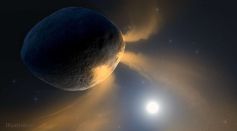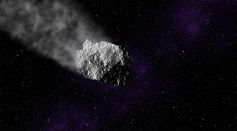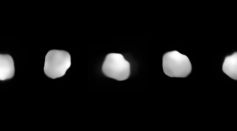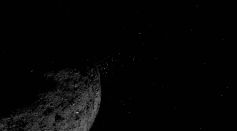Tags: Asteroid
Near-Earth Object Bigger Than Statue of Liberty Will Not Harm Planet; 2021 NY1 and 17 Other Asteroids Will Fly By in September
Asteroid Belt's Giant Space Rock Presents Unsolvable Puzzle: Vesta Craters Could Shed Light on Earth's Origin
NASA Scientists Testing Asteroid Deflection Methods To Prevent Space Rocks From Hitting Earth

Will This Fastest Orbiting 0.6-Mile Wide Asteroid Found in Solar System Reach Earth?

NASA Classifies Asteroid Approaching Earth 'Potentially Hazardous'; When Does Near-Earth Object Become Threat?

Asteroid 3200 Phaethon Has a Comet-Like Tail That Fizzes Near the Sun, Here's Why

NASA's OSIRIS-REx Says Asteroid Bennu Has 1-in-1750 Chance to Make Near-Earth Approach in Next 300 Years
Dinosaur Killer Chicxulub: Is It an Asteroid or Comet? New Theory Suggests Potential Origin of Space Rock That Ended Dino Species

First High-Resolution Imaging Captures Asteroid Thermal Emission Through NASA's ALMA Telescope
16 Psyche Asteroid: NASA Sending 2022 Mission to $10,000 Quadrillion-Worth Metallic Space Rock to Study Its Origin

World's Youngest Astronomer: 7-Year-Old Brazilian Girl Finds 7 Asteroids for NASA!

Lessons from COVID-19: How People Can Prepare For an Asteroid Impact

Great Pyramid of Giza-Sized Asteroid to 'Close' Approach Earth Soon, Should We Worry?

NASA Says Asteroid Twice as Big as Big Ben Will Make Near-Earth Approach; Should We Worry?
Chicxulub-Sized Space Rocks Hit Early Earth Every 15 Million Years, Research Suggests Impacts Developed Life

Ryugu's First Sample Arrived, NASA Conducts Examination of Asteroid

NASA's Near-Earth Object Surveyor Space Telescope Now One Step Closer to Reality
Did the Boltysh Crater Caused Dinosaur Extinction? New Study Reveals a Different Story

China Launches Near-Earth Hunting Satellites To Space On Board Long March 2D Rocket

NASA Approves Near-Earth Object Space Telescope; Will It Improve Planetary Defense Efforts?
Most Popular

Microplastics Are Everywhere — How Plastic Pollution Threatens Wildlife, Soil, and Water

Brain Health Aging Guide: Effective Strategies for Cognitive Decline Prevention and Lower Dementia Risk

Mitochondrial Health and Aging: How Cell Energy Drives Modern Anti-Aging Science

How Scientists Use Radio Telescopes to Search for Alien Signals Across the Universe




